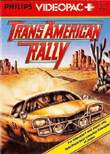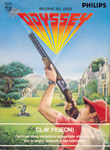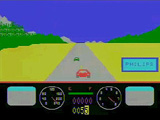Göran Öhman: The Last Videopac Programmer?
Göran Öhman could very well have been the last of the original Videopac programmers. As an employee for Intron AB, a small firm based in Stockholm that developed Videopac games for Philips on a consultancy basis, he programmed Trans-American Rally, the last original Videopac game released in Europe. He also created Clay Pigeon, which only saw a release in the last part of the world to have an active Videopac/Odyssey market: Brazil. In fact, Göran's games were so late in Videopac history that he didn't even realize they'd been released at all – at least, not until years later when he found some Videopac fan sites on the Internet. Surprised that there was still interest in the system after all those years, he created VpacApp, a Videopac emulator project he used to learn Java and Android programming.
Once I learned about VpacApp, I contacted Göran and asked him a few questions about his time at Intron, which he was kind enough to answer. In the time since our conversation, VpacApp has disappeared from the Google Play store (it used to be here). I don't know why it has been taken down. While it was up, it included ROMs for several original Videopac games, but Mr. Öhman had actually obtained permission from Philips to distribute them. Here's hoping it returns soon. In the meantime, here is some text from our conversation, edited for clarity.
William Cassidy (WC): It is always interesting to meet a Videopac programmer who worked back in the 1980s. I would love to ask you more questions about your work back then. Did you work for Philips?


Göran Öhman: My first job after university, in 1982, was at a small firm in Stockholm, Sweden: Intron AB. Intron was owned by Peter Inser, who was a Videopac developer and a former employee of Philips. We were three developers who made games for Philips on a consultancy basis. We had good connections with the head of game development at Philips Eindhoven. He was from Sweden and an old colleague of Mr. Inser.
I made the games Clay Pigeon and Trans-American Rally myself, and together with a couple of colleagues, Frogger. I do not remember which other games Intron made but I think that Helicopter Rescue was one of them. My colleagues also made some games for the MSX game console.
I left Intron in 1985 to develop medical imaging systems, and I lost contact with Intron and my colleagues, but I know that they later moved to Eindhoven to continue the work with MSX. Philips was closing down the Videopac system at that time, and I never saw any of my games come to market. Some years ago, I was updating my resume, and Googled "Videopac" for fun, and to my surprise discovered your and other sites and that there still was interest in the old Videopac.
WC: Congratulations for publishing a Videopac emulator for Android! Are you planning to release any updates, new games or enhancements?
Öhman: A year ago I decided to start learning Android programming, and I thought an emulator could be a fun project. My immediate plan for VpacApp is to support Videopac+ and to improve the emulator (some games do not work properly now). Also support for larger screens could be better, and there will surely be some bugfixes. I have no time schedule though as this is a hobby project.
WC: The description on the Google Play Store makes it sound like Philips was involved. Is this an official Philips software?
Öhman: I have the permission from Philips to distribute the games. Apart from that, Philips is not involved at all. I have tried to get permission for other games, with no success. It is difficult to track down the original publishers. I found a contact with Parker Brothers (Frogger, Q*bert), and they were positive about giving permission, but they were not sure if they still owned the rights.
WC: It is amazing to me that you got any kind of permission from Philips. Others have contacted them with no luck. It seemed like they had forgotten that Videopac ever existed.
Öhman: I must have been lucky with Philips (or TPV as the TV-division is known). I mailed a general information address, and a couple of weeks later got a mail from a person at a legal department. I got the permission after some mail conversation about the conditions. It might have helped that I had made some games for Philips; I do not know.
WC: The Parker Brothers rights will be difficult to find. I think Parker is owned by Hasbro now, but I think the original arcade games are owned by Konami (Frogger and Super Cobra), Sony (Q*bert) and Nintendo (Popeye). I have no idea who has the rights to the Videopac versions.
Öhman: Regarding Hasbro, the person I had contact with was very friendly, but said that as this was so long ago, that they do not have any records easily available and cannot justify the cost to search in old archives just to give something away for free.
The French company Thomson CSF made games (I made a short visit to them when I was at Intron), and from what I have found out, they are now a branch of Technicolor, but I have not been able to get a contact there.
Videopac also had a prolonged life in Brazil (I held a Videopac programming course for a guy from Philips Brazil), but I have no idea of which company to contact.
WC: How did you come to work at Intron? Were you hoping to work on games?
Öhman: I graduated from university 1982, as a Master of Science in technical physics. The course had some focus on software development, and I was very interested in this area. My programming experience was limited though. This was pre-PC, and all my programming was done at school. The job was a coincidence; I started looking for a software job, and read an advertisement by Intron that said something like "working with video-control." There was no mention of games, and the company was situated in the same area of Stockholm as the national TV-company, so I thought that maybe they worked with broadcasting equipment.
I called Mr. Inser, and when he told me that the job was about game programming, I said that I would very much like this job. I was interested in games, and played coin-op arcade machines, but had never even seen a Videopac before. I got the job. The market for software developers was extremely good at that time and there were a lot of job opportunities.
WC: How many people worked at Intron?
Öhman: There were 3-5 employees as I recall. I was the first employee, but not long after me, two other persons were hired on a permanent basis. They were also new from university. At the peak, there were extra part-timers (two I think). Mr. Inser had developed some games, but as I remember, during my time at Intron, he concentrated on the business and did limited programming.
WC: What was the first game you worked on? What was your role in developing that game?
Öhman: My first game was Clay Pigeon (my first-ever professional program!), and I did it myself, after some introduction from Mr. Inser.
WC: Were Clay Pigeon and Trans-American Rally assigned to you or did you come up with the game designs yourself?
Öhman: As I recall it, the projects were very informal. We, or Philips, had a general idea of a game, and then you had very much freedom to do the implementation. Philips later made some effort to formalize the projects; you had to write a detailed specification before you started, but during the development, there were lots of changes.
The general idea for Clay Pigeon came from Philips or Mr. Inser, but I did the design. I got the idea for Trans-American Rally from an arcade game (called OutRun I think). During development of a game we worked some time at Philips in Eindhoven. At the Schipol airport in Amsterdam, there was a game room with arcade machines, and I spent some time there, playing OutRun, waiting for my flight to Stockholm. The Atari 2600 game Pole Position also gave me ideas of how to simplify the graphics for a console with limited capability.
WC: How much of those two games did you develop? (Did you produce the game logic, graphics, sound, animation...?)
Öhman: As I recall it: In Clay Pigeon and Trans-American Rally, I made everything. In Frogger, I made the game logic, my colleagues made some of the graphics design, and the sound was done by a short-time employee – I do not remember his name, but he was very good with music. My colleagues also did much of the testing.
WC: The version of Clay Pigeon released in Brazil did not contain high-resolution G7400 background graphics, but a prototype later found in the Netherlands did. Did you create the G7400 version?
Öhman: Philips added G7400 backgrounds for several games, including Clay Pigeon. I think I saw the background at one of my visits to Philips.
WC: Trans-American Rally works only on the G7400. Did you find it easier or more challenging to work on a game for the more-powerful console?

Öhman: This will get a bit technical. I would say that there was no major difference; they were equally challenging. The most limiting factor with the G7000 and G7400 as I remember is the CPU performance. The graphics resolution is low and there are a limited number of screen objects, but there are tricks, like in Frogger, to increase the number of objects. The problem is that, the screen can only be updated during blanking intervals, and as the RAM is very small, it is difficult to prepare visual objects off-screen and write them to screen during the blanking intervals.
The extra graphics chip in the G7400 was intended for Teletext character display in TV sets and is not very suitable for dynamic objects. There are a number of programmable characters, and I made a small program to draw arbitrary graphics on screen through this function. Only a part of the screen can be covered this way (¼ of a screen I think), so Philips was not interested in pushing this idea more. Crude graphics can be drawn through the fixed character set, and this was used in Trans-American Rally, but this is rather slow and complex.
WC: Trans-American Rally is set in the United States, but since it is a G7400 game, it could never have come out in that country. Did you know that when you were creating it? Did Intron, a Swedish company, have any particular reason for setting the game in the U.S.?
Öhman: As I recall, Philips wanted a game that used a bit more of the G7400 than just a static background. The idea came from OutRun and Pole Position; Intron had no connection with the U.S.
WC: You mentioned that you never saw any of your games get released. Trans-American Rally was the last Videopac game released, in limited quantities. Clay Pigeon was released in Brazil only. Were you unaware of this at the time? When did you finally find out they were released, and how did you feel about it?
Öhman: I left Intron in 1985 for technically more challenging work in medical image processing. None of the games we had developed at Intron had been released at that time, but this was normal I think. There was a long production setup time. I lost contact with my former colleagues, but I heard that they moved to Holland to continue game development for the MSX.
Maybe five years ago, I was rewriting my CV, and mostly for fun Googled "Videopac." I was quite surprised of the interest in Videopac that I found at your and other sites. I had thought that the Videopac was long forgotten. I also found my games, which was even more of a surprise. When I left Intron, there were rumors that Philips was to close down the Videopac business.
A little anecdote about the Frogger game: when Parker Brothers saw it, they asked Intron if we could improve the graphics in the Q*bert game, but the company that developed Q*bert refused to hand out the source code so we had to decline the offer. According to Mr. Inser, Parker Brothers considered not publishing any Videopac game at all, as the Frogger graphics were so superior to their other games.
WC: During your time at Intron, was the company only a Videopac game developer or did it work on other projects?
Öhman: When I left, Intron was busy developing games for the MSX system. I personally did not develop any games for the MSX. I was partly involved as a senior programmer assisting the temporary employees a bit.
WC: You mentioned that you made a short visit to Thomson CSF while at Intron. I don't know much about Thomson, except that they made the "Jopac" games. Did Intron have a relationship with them?
Öhman: We did not do any work for Thomson CSF. This was obviously a sensitive area. Mr. Inser told me not to mention my visit there to Philips.
WC: Did you personally work on other projects while at Intron?
Öhman: There was a special cassette for service technicians; I made additions to the service program to exercise the new hardware in the G7400.
WC: You mentioned Peter Inser. Are there any other peoples' names you can remember from Intron or Philips that worked on Videopac?
Öhman: I am not absolutely sure of any of these names but...
Philips:
- Mr. Christer Medin. I think he made games together with Mr. Inser at Philips, not sure though.
- Kees (first name only). He made backgrounds, and minor changes in games.
My colleagues at Intron:
- Erkka Suopanki
- Gudmund (first name only)
The other names, I cannot recall.
WC: Gil Williamson from The Amazon Systems mentioned that Peter Inser once taught his company a class on Videopac programming. Did you happen to meet Gil or anyone from his company?
Öhman: I do not recall this name or company. I held a similar class for a man from Philips in Brazil, but I do not recall his name.


WC: Do you still have any games, photos or mementos of your time at Intron? Maybe an Intron logo?
Öhman: I attached an Intron logo, a low quality scan from a black-and-white copy. Somewhere I have a color original, but I cannot find it right now. I have a console, and somewhere in the basement, there are some game prototype boards. I had them a month ago, but now they have temporarily disappeared.
WC: If the prototype boards turn up, I'm sure that all the Videopac enthusiasts out there would be interested to see what data is on them! After Intron, did you ever work in the gaming industry again? What made you decide to work on an Android Videopac emulator?
Öhman: After Intron I have worked in completely different areas. Among other things, I have worked with medical equipment and production systems for identity- and credit-cards. The gaming industry in Sweden is quite strong now, but I have never had any contact with it, and Videopac programming experience would probably not be a merit.
I decided to learn Java and Android programming, and as a reference I wanted to make a "real" application. The interest around the Web for the Videopac inspired me. I had earlier found the O2EM emulator for PC, so I knew it could be done. I also found several Android emulators for Atari 2600 but none for the Videopac. I wanted the app to be complete with games, so when I got the permission from Philips, it was just to start developing.
WC: Looking back now, what are your memories of your time at Intron and the gaming industry back then?
Öhman: My memories from that time are only positive. The job was fun, I like challenges and to find new solutions, and every game was a completely new project. Most programmers would have loved this job: there was very much freedom, and no documentation! Philips was really only interested in the delivery of a bug-free game in an EEPROM.
This was pre-Internet times, so you could not Google any information or download any code, you had to invent everything yourself. I developed algorithms that I later found much better versions of. This also meant that you did not have any contact with companies outside your own. The only way to check out the competition was to buy a game in a store. We had an Atari 2600 at the office and spent quite a lot of time with it. (I have to admit that their games generally are a bit better.) When we developed some of the games (Frogger, Buck Rogers and another game), we had the corresponding coin-op arcade machines in the office as a reference to make faithful copies.
WC: Was Intron porting the coin-op game Buck Rogers? I know it was ported to other systems, such Atari 2600 and ColecoVision, but had not heard it was planned for Videopac.
Öhman: Intron ported Buck Rogers and a couple of other games to the MSX-console (for Philips I think). As far as I remember there were no plans to port it to Videopac. Maybe we were asked, but turned down the idea, as Buck Rogers was too advanced for the Videopac hardware.
I'd like to thank Mr. Öhman for his time answering my questions, for providing the Intron logo, and of course for his work programming Videopac games and VpacApp! Hopefully the latter will return to the Google Play Store soon.